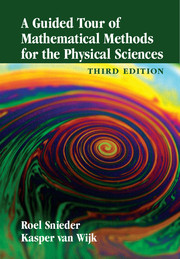Book contents
- Frontmatter
- Contents
- List of figures
- List of tables
- About the authors
- 1 Introduction
- 2 Dimensional analysis
- 3 Power series
- 4 Spherical and cylindrical coordinates
- 5 Gradient
- 6 Divergence of a vector field
- 7 Curl of a vector field
- 8 Theorem of Gauss
- 9 Theorem of Stokes
- 10 The Laplacian
- 11 Scale analysis
- 12 Linear algebra
- 13 Dirac delta function
- 14 Fourier analysis
- 15 Analytic functions
- 16 Complex integration
- 17 Green's functions: principles
- 18 Green's functions: examples
- 19 Normal modes
- 20 Potential field theory
- 21 Probability and statistics
- 22 Inverse problems
- 23 Perturbation theory
- 24 Asymptotic evaluation of integrals
- 25 Conservation laws
- 26 Cartesian tensors
- 27 Variational calculus
- 28 Epilogue, on power and knowledge
- References
- Index
23 - Perturbation theory
Published online by Cambridge University Press: 05 March 2015
- Frontmatter
- Contents
- List of figures
- List of tables
- About the authors
- 1 Introduction
- 2 Dimensional analysis
- 3 Power series
- 4 Spherical and cylindrical coordinates
- 5 Gradient
- 6 Divergence of a vector field
- 7 Curl of a vector field
- 8 Theorem of Gauss
- 9 Theorem of Stokes
- 10 The Laplacian
- 11 Scale analysis
- 12 Linear algebra
- 13 Dirac delta function
- 14 Fourier analysis
- 15 Analytic functions
- 16 Complex integration
- 17 Green's functions: principles
- 18 Green's functions: examples
- 19 Normal modes
- 20 Potential field theory
- 21 Probability and statistics
- 22 Inverse problems
- 23 Perturbation theory
- 24 Asymptotic evaluation of integrals
- 25 Conservation laws
- 26 Cartesian tensors
- 27 Variational calculus
- 28 Epilogue, on power and knowledge
- References
- Index
Summary
From this book and most other books on mathematical physics, you may have obtained the impression that most equations in the physical sciences can be solved. This is actually not true; most textbooks (including this book) give an unrepresentative state of affairs by only showing the problems that can be solved in closed form. It is an interesting paradox that as our theories of the physical world become more accurate, the resulting equations become more difficult to solve. In classical mechanics the problem of two particles that interact with a central force can be solved in closed form, but the three-body problem in which three particles interact has no analytical solution. In quantum mechanics, the one-body problem of a particle that moves in a potential can be solved for a limited number of situations only: for the free particle, the particle in a box, the harmonic oscillator, and the hydrogen atom. In this sense the one-body problem in quantum mechanics has no general solution. This shows that as a theory becomes more accurate, the resulting complexity of the equations makes it often more difficult to actually find solutions.
One way to proceed is to compute numerical solutions of the equations. Computers are a powerful tool and can be extremely useful in solving physical problems. Another approach is to find approximate solutions to the equations. In Chapter 11, scale analysis was used to drop from the equations terms that are of minor importance. In this chapter, a systematic method is introduced to account for terms in the equations that are small but that make the equations difficult to solve. The idea is that a complex problem is compared to a simpler problem that can be solved in closed form, and to consider these small terms as a perturbation to the original equation. The theory of this chapter then makes it possible to determine how the solution is perturbed by the perturbation in the original equation; this technique is called perturbation theory.
- Type
- Chapter
- Information
- A Guided Tour of Mathematical Methods for the Physical Sciences , pp. 416 - 441Publisher: Cambridge University PressPrint publication year: 2015



